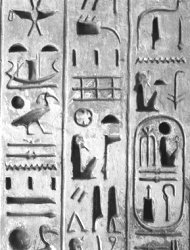UPDATE: Learned from @indiekid and @w1redone over dinner that (a) others were using this convention two months earlier in California (doh!) and (b) there is a site dedicated to tracking hashtags: hashtags.org. Cool that Jason and I independently hit upon the same symbol to indicate locations.
The web has a new convention for usernames, could we use one for locations? And why do these things catch on?

In Egyptian Hieroglyphics, names were always circled–an early example of semantic tagging.
Twitter users created the ‘@username’ convention on their own almost as soon as the service started, and it has now spread beyond twitter. Usernames are prefixed with a @ symbol to indicate that you’re talking about a person, and the system can turn that name into a link.
In December Jason Lange and I hatched the idea of using hash marks to indicate locations. We settled on the # symbol because (a) @ is already taken (b) it sorta looks like grid lines and (c) it is used URL’s to indicate a location on a page. Of course, we twittered our new idea:
Brainstorming like crazy with @susqhanamj at #trilogy. - 09:15 PM December 07, 2007
At dinner last night, I heard the folks at Twitter HQ are talking about the this geo-hash convention.
But what is it good for? Imagine if each location had it’s own page. So in my tweet above, you could click through to a #trilogy page for the Trilogy Wine Bar in Boulder. You could see other people who have talked about it and get a sense for the sort of people who go there.
Who creates content for these pages? Twitter could allow businesses to create their own accounts (as Facebook now does), but that wouldn’t cover things like parks and geographic landmarks. So better yet: make locations into Wiki pages that anyone can edit.
No word from Egyptologists on what symbols they used for locations…